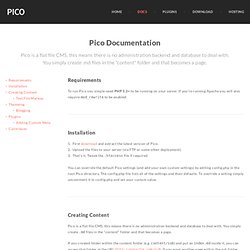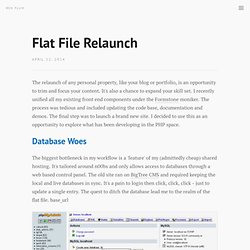

Ahmet2106/pico-navigation. Cache plugin for Pico CMS. If you use the Pico CMS for a mostly static blog, like I do, there is no need to parse the markdown files and render the twig templates on every request.

Therefore I made the Pico Cache plugin. I did some testing and it turns out that the cache plugin speeds up the page pretty well. With one user at a time, the average response time was 315ms without cache and 10ms with cache enabled. (97% less time) Having 100 concurrent users, the average response time without cache was 14640ms and with cache 267ms. (98% less time) I repeated this tests 1000 times on a fairly old macbook, so the actual values are not that convincing, but rather the response time savings in percentage. Installation To install the Pico Cache plugin, simply download the pico_cache.php from GitHub and put it in the plugins directory {picoInstallation}/plugins/. Usage and Configuration The plugin comes with some sensible defaults, but you can of course configure them.
Download Pico Cache. Narcis-radu/pico-pure. Pico Themes · picocms/Pico Wiki. Picocms/Pico. Using Pico with Nginx · picocms/Pico Wiki. Documentation. You can override the default Pico settings (and add your own custom settings) by editing config.php in the root Pico directory.

The config.php file lists all of the settings and their defaults. To override a setting simply uncomment it in config.php and set your custom value. Creating Content Pico is a flat file CMS, this means there is no administration backend and database to deal with. You simply create .md files in the "content" folder and that becomes a page. If you created folder within the content folder (e.g. content/sub) and put an index.md inside it, you can access that folder at the URL If you want another page within the sub folder, simply create a text file with the corresponding name (e.g. content/sub/page.md) and will be able to access it from the URL Below we've shown some examples of content locations and their corresponing URL's: If a file cannot be found, the file content/404.md will be shown.
Text File Markup Text files are marked up using Markdown. Themeing Blogging. Plugins. Want to extend the functionality of Pico?

Below is a collection of our community-developed plugins. Would you like to create your own plugin? Learn how in our documentation! The plugins shown here are only a smaller selection of those available. You can find more plugins on our Wiki. You can even contribute your own plugin to the community and we’ll feature it here. We appreciate any and all contributions, whether you’ve created something new or restored an obsolete plugin, we’d love to see it! Pico Plugins · picocms/Pico Wiki. John-cheesman/pico-rss-content. Flat File Relaunch · Ben Plum. The relaunch of any personal property, like your blog or portfolio, is an opportunity to trim and focus your content.

It's also a chance to expand your skill set. I recently unified all my existing front end components under the Formstone moniker. The process was tedious and included updating the code base, documentation and demos. The final step was to launch a brand new site. I decided to use this as an opportunity to explore what has been developing in the PHP space. Database Woes The biggest bottleneck in my workflow is a 'feature' of my (admittedly cheap) shared hosting. Look familiar? Now, you may being saying to yourself "just switch hosts, ya' dummy. " Entering the Flatland Flat file setups are what all the kids are talking about these days, and for good reason. I started my search by outlining a few pieces of criteria to consider when sizing up the contenders: PHP basedOpen sourceFile system based page treeFast page renderingAbility to extend or add functionality. Pico - A stupidly simple, blazing fast, flat file CMS. Plugins.